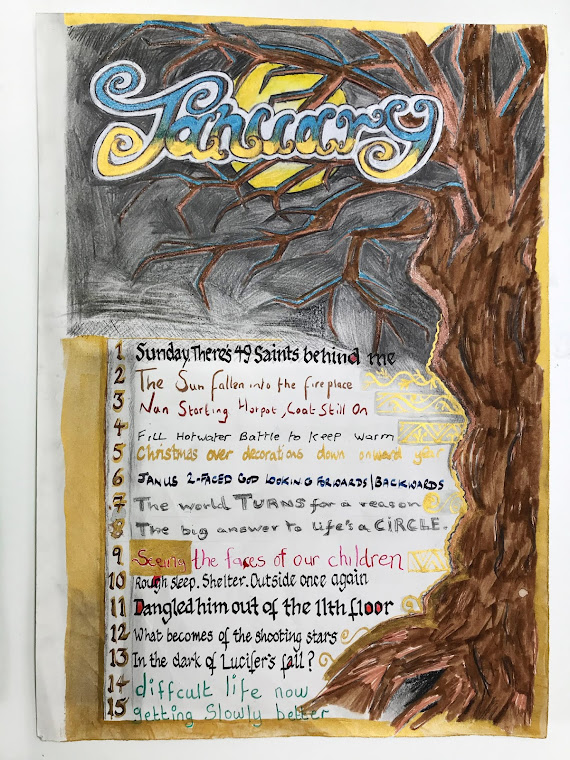If any one line (or grouping of lines) in the Calendar is observed singly, it comes forward as a visible notation of the vast store of thinking, dreaming, and experience of the individual who wrote it. A reader, reading from the point of view of the unique individual, can acknowledge that overwhelmingly excluded life; it’s as if a prisoner in solitary confinement uttered a phrase only to be swallowed up in the darkness of their uniqueness; indeed, solitary confinement reinforces a prisoner’s uniqueness and is the prison industry’s way of disarming a person of any collective identity or power. I realize that my notion of “coherence” refers to the exfoliation of a person strictly as individual consciousness. Does this explain the unsettling effect of reading the Calendar: every fragment immediately is sutured to (listed next to) another, which transforms it into something very different from it as singular, not a fragment but a whole that fits among other wholes creating a collective, which is to say an art-of-coexistence. All of these utterances drawn into immediately proximity make something vaster and more powerful than the word “community” or the word “class” or even the word “homelessness” registers: the sum of the parts exceed the whole.
I asked Lois about the proposed audience for A Book of Ours, and she first answered as I expected: the participants are the audience—proud of their work and impassioned by their collaborations. Those near the bottom rung of society have found visibility as the “utopian margin,” co-existing in their “making-unmaking” (Maggie O’Sullivan) of text and image, claiming within their own domains, at once social and haunted, the great art of the past for inspiration. Passion, she said repeatedly, drives Lois in her work with the homeless. And where on the page has passion found a place?—in the Calendar at those (many) moments of striking contrast in the text. For example,
The world Turns for a reason
The big answer to Life’s a CIRCLE.
Seeing the faces of our children
Rough sleep. Shelter, Outside once again
Dangled him out of the 11th floor
What becomes of the shooting stars
In the dark of Lucifer’s fall?
difficult life now
getting slowly better
On the page colors vary among the lines as do styles of writing from the free hand of a scribe to calligraphy, all of which adds to contrast. Contrast at the level of statement and vision excites and rivets a reader/viewer past all class and education difference. And it creates a moment that aligns participant and the casual visitor to a public exhibition (cathedral, library, university) of A Book of Ours in a single perceptual and emotional vantage point. It’s not “us” the makers versus “them” the audience. It creates an audience of “us.” From the perspective of these contrasts, the culturally mainstream values of “unity” and “harmony” suddenly appear artificially imposed, suppressing the genuine innate difference articulated among people. Contrast in A Book of Ours accords with the alternate tradition of radical poetics formulated by Bertolt Brecht (in drama a “scene” of the fact of capitalist society: wealth and poverty, agency and helplessness) and others, and further indicating the coming together of a diverse humanity, and us, with a common purpose of recovering and expressing human dignity. And as I read slowly, awkwardly across these lines, I feel a hand, rough yet gentle, from a person, not precisely a single person, pressing against my arm.
A BOOK OF OURS was exhibited at Bury Art Museum May-July 2021, then Manchester Cathedral Oct 2021-March 2022, after which it went permanently into the collection at John Rylands Library, where it can now be viewed. It is the last project by arthur+martha CIC.



Lucky Club Casino Site - VIP VIP Club
ReplyDeleteLucky Club Casino – an excellent VIP club, the best place to get a gambling and Lucky Club Casino luckyclub.live is an excellent VIP club, the best place to get a gambling and